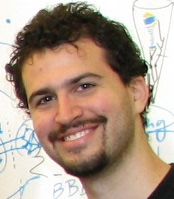Nagle Lecture Series
2012 Nagle Lecture
Erez Lieberman Aiden
How the Human Genome Folds
April 18, 2012
Description of the Talk
Nearly seven feet long, your genome is probably taller than you are. So how does it fit inside the nucleus of a cell — a space far narrower than a human hair? For over a century, people have had ideas about this problem, and have struggled to test them. In the last few years, there has been exciting progress, fueled by new technologies that allow us to sequence genomes in 3D. The results have not only inspired a better understanding of biology, but have led to exciting discoveries in physics and mathematics as well. My talk will describe the history of this problem, my work to develop the first technology for three dimensional genome sequencing, our current understanding of how genomes fold, and the unexpected ways in which this work has inspired discoveries in a wide array of fields.
Description of the Speaker

Erez Lieberman Aiden is a fellow at the Harvard Society of Fellows and Visiting Faculty at Google. His work integrates mathematical and physical theory with the invention of new technologies.
He recently invented a method for three-dimensional genome sequencing; he subsequently led the team that, in 2009, reported the first three dimensional map of the human genome. Together with collaborator Jean-Baptiste Michel, he developed culturomics, a quantitative approach to the study of history and culture that relies on computational analysis of a significant fraction of the historical record. This work led to the creation of the Google Ngram Viewer, a supplemental website that was visited over a million times in the 24 hours after its launch.
Erez's research has won numerous awards, including a $2.5M NIH New Innovator Award; the GE & Science Prize for Young Life Scientists; the Lemelson-MIT prize for the best student inventor at MIT; the American Physical Society's Award for the Best Doctoral Dissertation in Biological Physics; recognition for one of the top 20 "Biotech Breakthroughs that will Change Medicine", by Popular Mechanics; and membership in Technology Review's 2009 TR35, recognizing the top 35 innovators under 35. His last three research articles have all appeared on the cover of Nature and Science. His work has also been featured on the front page of the New York Times, the Boston Globe, and the Wall Street Journal.
The Organizing Committee of the NLS consists of Fernando Burgos (Chair), Nataša Jonoska, Dmitry Khavinson, Sherwin Kouchekian and Vilmos Totik. The Committee thanks the USF Department of Mathematics and Statistics and the College of Arts and Sciences for sponsoring this event.